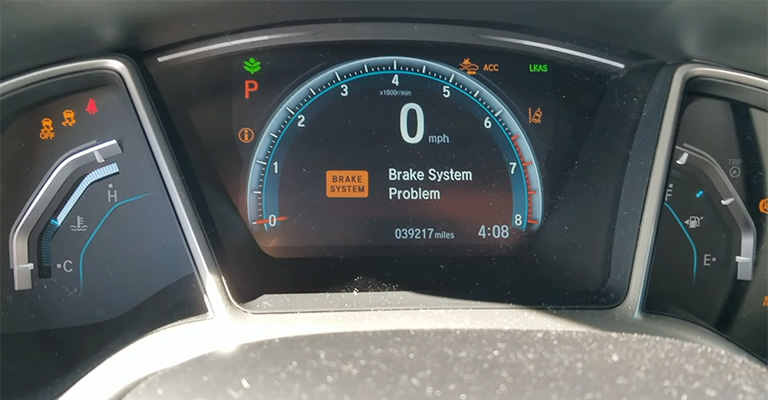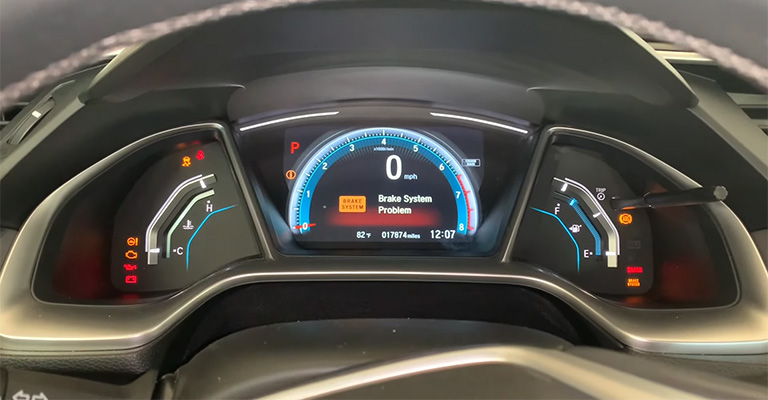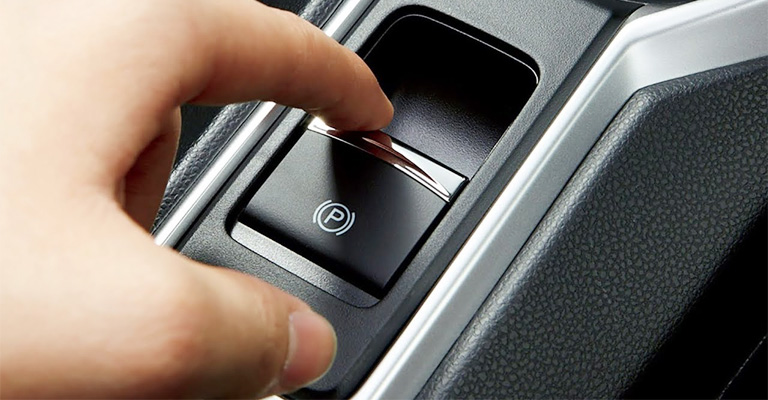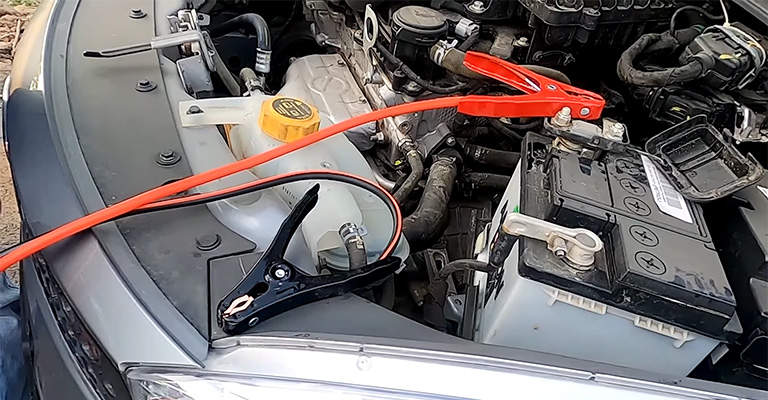The Honda Civic is a popular and reliable car that has earned a reputation for its sleek design, fuel efficiency, and overall performance.
However, even the most dependable vehicles can experience problems, and one issue that has plagued some Honda Civics is related to the brake system.
Regarding safety, the brakes are one of the most critical components of any car, so it’s essential to be aware of any potential problems that could put you and your passengers at risk.
In this article, we’ll dive into the common brake system problems that Honda Civic owners have reported and what you can do to address them. So, buckle up, and let’s take a closer look at the Honda Civic brake system problem.
When a Honda Civic doesn’t start, the brakes are likely what is causing it. You will want to pull the fuse for the electronic parking brake.
Another possibility is that there is a problem with the battery or the battery terminals. Some consumers have reported the same issue of a brake system light and an inability to start the vehicle.
Bad batteries either need to be charged or replaced to fix this problem. Depending on the quality and brand of the battery, you will pay between $100 and $150. It is essential to make sure that your battery is charging properly.

Troubleshooting Honda Civic Brake System Problem & Car Won’t Start
The Honda Civic displays surprising error messages when it fails to start. It is most likely a dead battery that’s responsible for one of these notices citing a problem with the brake system.
Most likely, this problem will affect the 2016 Honda Civic across all model years. Using this guide, you’ll learn all you need to know about the most feasible solution to this issue.
What Is The Honda Civic Brake System Problem That Affects Startup?

The error messages shown in the video above will appear if a dead battery causes the problem. A new battery will start your car up and run like new again if that’s the case.
Unfortunately, things aren’t always that simple. In some cases, the problem is with the fuse box. There are other times when it might be a brake switch.
The switch is likely damaged if you feel that your brake pedal is stiff or hard to push down.
If you’re not sure which of these problems your car has, you can take it to a dealer and have it diagnosed.
First, they will check the battery to see if it needs to be replaced. Before moving forward, they may install a test battery to confirm it seems okay.
They can then narrow down the causes and find the culprit by following the diagnostic steps for each suspected system. Once that’s done, it’s only a matter of replacing the offending part to restart your Civic.
The Electronic Parking Brake Is Stuck

There are many instances in which the “Brake System Problem” is also accompanied by a warning about the electric parking brake (EPB). A car on an incline can be kept stationary using the EPB as a stabilizing system.
It will warn the driver when the EPB fails and prevent the car from being driven when the system detects this. Usually, this occurs due to an EPB being stuck in its engaged position and needing to be released.
Whenever you see a warning that the brake system is failing on your Honda Civic, the first thing you should check is your electronic power steering (EPB). You can also press the release button on the center console to release it if it is locked.
If this does not work, it may be necessary to physically disengage the EPB by pulling on the release lever near the parking brake pedal if this does not work.
Following the EPB release, you should be able to drive your Honda Civic as usual. To ensure that no further issues arise, it is vital to get the EPB serviced as soon as possible.
You might have difficulty releasing the parking brake manually or automatically. Several reasons may contribute to it getting stuck:
- A frozen parking brake could be due to wet or cold weather.
- The Ebrakes are applied too hard.
- Corroded brakes due to water and dirt.
- The Ebrakes are applied too long.
The Fuse Box Is Acting Up

It may be that a brake light system fuse has failed, causing the brake lights not to work. Brake lights are also electrical components of a car, which are operated by fuses. Fuse boxes fail if electricity cannot reach the lights.
Low Battery Or Loose Battery Terminal
There is a risk of an electrical system becoming insufficiently powered if a battery is low or the battery terminal is damaged.
In addition to causing issues with the car’s starting – or starting slowly – as well as the brake system, a low battery or loose battery terminal can affect other components. The following solutions can help you resolve this issue easily:
Jumpstart the car battery:

- Get a car that runs.
- You should remove the ignitions from both vehicles.
- Using a jumper cable, connect the positive side to the positive terminal of the low battery while placing the negative cable on the ground. If a metal is attached to an electrical component, it must not be touched (check your manual).
- If the good battery is good, connect the negative cable to the negative terminal of the good battery. Make sure you connect to the low battery first since it has insufficient power.
- After that, start the car’s engine with a good battery and let it run for a few minutes.
- Ensure that the negative terminal of the bad battery is first removed, followed by the positive terminal.
Recharge the battery:
- You need to remove the vehicle’s battery so that it can be prepared.
- During this process, turn off all car electronics to prevent an electric arc from forming on the battery.
- Ensure the negative cable is removed before the positive cable. Ensure that the battery terminals are clean before connecting them to the charger.
- Charge the battery by connecting the positive and negative terminals of the charging unit to the corresponding positive and negative terminals of the battery.
- Once charging is done, disconnect the battery from the charger.
The Link Between the Brakes and Starting System
Honda Civics are push-to-start vehicles, so slapping the brake pedal down will start the car. The car will only go into accessory mode if you don’t push the brake as you press the button.
As a result of this safety mechanism, you’ll be ready to pilot the vehicle upon startup, but it can be problematic if any part fails. As soon as the brake pedal switch fails, for example, the car will not know you’re braking.
In this case, the car refuses to start, leaving you wondering what went wrong. Many startup problems are related to a dead battery, which causes an array of error messages to appear. As a result, you may think that the problem is because of a bad brake switch when it’s not.
How Do You Get Rid Of Brake Hold?
You can get rid of the brake hold by:
- Applying Braking for more than 10 minutes.
- Engaging the electric parking brake.
- Pressing the foot brake and moving the shift lever to P or R.
- Stalling engine stalls
- Unfastened driver’s seat belt.
- Turning off the engine.
How Do You Reset The Brake Hold System On A Honda Civic?
The brake hold system on the Honda Civic must be reset by pressing the brake pedal and then pressing the BRAKE HOLD button again.
How To Reset The Electric Parking Brake On A Honda Civic?
Following are the steps you can follow to reset the Electric Parking Brake:
When the ignition is on, shift into PARK while the gear lever is in PARK. Be careful not to depress the brake pedal.
- Activate the Electric Parking Brake by pulling and releasing the EPB button.
- Pull and hold the EPB button until there is a mechanical sound. After this, release the button.
- Then, pull and hold the EPB button for about 3 seconds until you hear two mechanical beeps.
How To Release The Electric Parking Brake On A Honda Civic?
Ensure that you have fastened your seat belt and pressed the brake pedal. When you are done pressing the switch, release it. In gear, you can release the clutch pedal by slightly pressing the accelerator pedal while releasing the clutch pedal.
How To Apply The Electric Parking Brake On A Honda Civic?
Once you’ve finished driving, you can apply the Electric Parking Brake. The switch must be pulled up for it to be used. In the instrument panel, you’ll find the brake indicator in order to stop the vehicle in an emergency and hold the emergency brake switch while in motion.
Final Words
It is essential for every car to have a good brake system. Understanding the causes of brake system problems can be crucial to owners of Honda Civic models.
A faulty electric parking brake, a software update, or a problem with the battery could all cause this.
The solution to these problems is straightforward. Battery problems can be resolved by jumping, starting, or replacing them.
If you need professional assistance, you can also follow the advice I have given you or contact an authorized dealer.
You should tow your car to a trustworthy mechanic if your brake systems are malfunctioning since they can pose a serious safety risk.
Jumpstarting a dead car battery might work, but it’s much safer to let a professional examine your car to make sure your dead battery is the real problem.

Leave a Reply